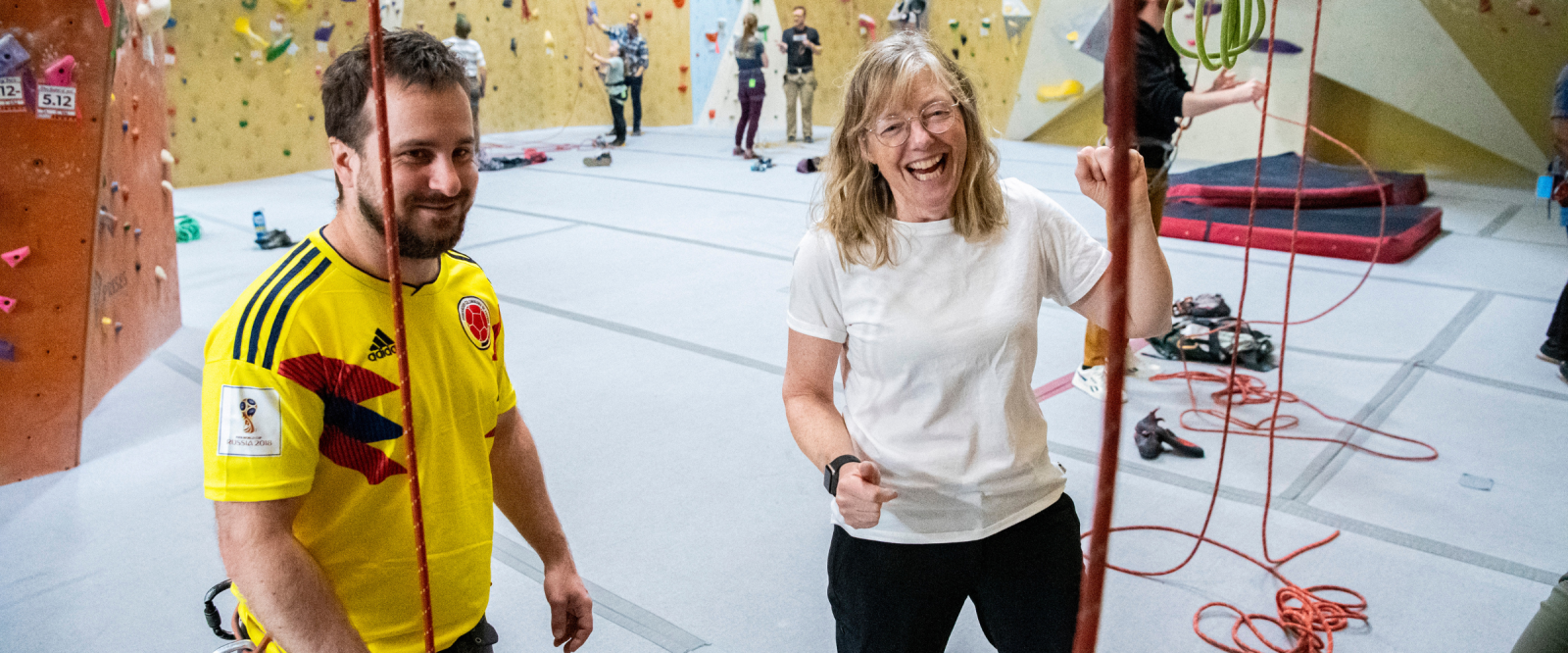Safe Sport and Indoor Climbing

As a young woman, I was an outdoor recreation enthusiast. Climbing, canoeing, hiking, camping, and skiing were all my favorite activities. I was fortunate to have access to guides to take me and my schoolmates out on these adventures.
Article At A Glance |
|
During one of these outings, an adult mentor made a passing comment to me that could be interpreted as inappropriate. I felt so uncomfortable about the comment that fellow campers mentioned to me I was talking about it in my sleep. I was so uncomfortable I later spoke to a school friend about it, and I did my best to prevent being alone with this person.
A few years later learned this guide behaved inappropriately with multiple high schoolers. When asked if I was also approached by this guide, I lied and said no. I was lucky.
The experiences, including an inappropriate advance, did not prevent me from continuing to pursue the recreational activities I love. I am fortunate to find myself still engaged in the sports and recreation world as a career. For many who are in sports and recreation who experience similar advances, the outcomes can lead to leaving sport altogether, or to years of therapy.
The following link will take you to a quick look at the results of the 2024 Athlete Culture and Climate Survey conducted by the US Center for Safe Sport.
In response to the exposure people have endured during participation in sports, governments have been moved to introduce regulatory guidelines and to provide resources and training to participants in sport and recreation at all levels
Both Canada and the US, along with most developed countries, endorse the Long-Term Development Model (sometimes also referred to as Long-Term Athlete Development Model, or LTAD) for sport participants.
READ ALSO: Applying LTAD to Every Generation
LTAD documents an athlete's stage/age through sport and whether their physical/mental development is being treated/trained appropriately.
The premise is that as a young person begins in physical activity, they develop fundamental movements, gaining physical literacy as they develop physically and progress in sport.
For example, a six-year-old will have muscle attachments (called tendons) to bones that are stronger than the developing bones themselves. When a young person loads these tendons with a high force, this force will likely result in a bone fracture rather than a torn tendon. The consequence of this type of injury can take longer to heal and have lifelong implications on bone development.
While an adult will typically not have that issue, one who lacks physical literacy may need to start with fundamental movements before progressing to more complex movements. For example, learning to walk again on a leg recovering from a break requires very simple movements, before movements requiring coordination.
Governments have taken action to combat situations that can hurt participants, whether at the Olympic level or in a more recreational setting.
Within the realm of all sports, there are various other programs and regulations designed to provide additional protection to participants. The US Center for SafeSport stems from the Safe Sport Authorization Act, a U.S. law designed to protect the rights and safety of minors from sexual assault or misconduct. The Minor Athlete Abuse Prevention Policies (MAAPP) provide sport governing bodies with resources to guide interactions between adults and young athletes.
Safety in Sport is a Canadian effort to rid sport of all forms of harassment, discrimination, and abuse for participants in any role at any age. To this end, Canada offers the Universal Code of Conduct to Prevent and Address Maltreatment, and Safe Sport training to participants in all sports.
The Movement for Responsible Coaching offers all sport participants tools and resources supporting a positive sport experience for participants.
The Universal Code of Conduct to Prevent and Address Maltreatment in Sport stipulates that participants should have a reasonable expectation when they participate in sport that they should experience an environment free from maltreatment and be treated with respect and dignity. Participants are defined as anyone involved in sport and is not limited to youth participants.
The Canadian Safe Sport training offers the learners three key areas of consideration.
- Acknowledgment that there are issues in how to make sport accessible, engaging and inclusive.
- Awareness of the signs of maltreatment.
- Action educates the learner on what one can take to prevent and reduce the maltreatment of anyone participating in sport. Part of the action is a duty to report any signs or indicators that a youth may be neglected or abused by a parent or guardian.
With these various resources and tools, it can be challenging to navigate the realm of sport as an athlete, a parent, a coach, and an organization offering sport programs.
Government Regulation
The U.S. Center for Safe Sport conducts an annual audit of the National Governing Body (NGB) of a particular sport. In the U.S., USA Climbing (USAC) is the NGB for competitive climbing. The 2024 USAC audit reviews a variety of factors including compliance with Safe Sport education and training, reporting, and response. Other than competitive events sanctioned by USAC, this audit would not apply to programs a climbing facility would offer.
Whether a coach, program director, or coordinator has a legal duty to report any suspected case of child abuse or neglect of a child participating in a climbing facility program is determined by the state, possibly the municipality.
In Canada, everyone must report. Climbing Escalade Canada (CEC) is the NBG for competitive climbing. The CEC has a duty to Sport Canada to ensure compliance with the Safe Sport policies. Each province has a provincial sport governing body reporting to the CEC when it comes to offering sanctioned competitions.
Coaches Canada must complete Safe Sport training to be recognized as a coach through CEC. Click the link for the details of trainings required.
CEC policies and practices are limited to the scope of competitive climbing. Climbing facilities offering regular non-CEC-sanctioned events would not be obligated to comply with CEC policies. However, the Sport Canada policies and requirements for Safe Sport compliance would impact them.
The Canadian Parks and Recreation Association recognizes the importance of including the policies of safe sport within it’s activities. In other words, implementing safety in sport policies is what a reasonable person would do.
Maltreatment is defined as treatment which can result in harm or has the potential for physical or psychological harm. This can include verbal conduct, non assaultive physical conduct, denial of support, physical contact and noncontact behaviours, neglect, sexual misconduct or assault, grooming, boundary transgressions, discrimination, subjecting someone to the risk of maltreatment, aiding and abetting maltreatment, failure to report, reporting a false allegation, interference with process, retaliation.
Get Involved & Learn More
The CWA recently launched our new Coaching and Training Committee. If you want to learn more about the topics in this article, please reach out to the committee. and they will happily assist you.
About The Author
 Heather Reynolds is a licensed kinesiologist, High Five Trainer (Sport, PCHD), CEC Climbing Coach, CWA Climbing Wall Instructor Certification Provider Trainer. She works as a Consultant to the CWA. She blends her knowledge of movement, physiology, and education to develop a multitude of successful climbing programs designed to support and engage youth. Having worked with youth for over 30 years as a recreation instructor, leader and educator, Heather supports the values and expertise available in the High Five Program, bringing quality assurance to youth-based sport and recreation programming.
Heather Reynolds is a licensed kinesiologist, High Five Trainer (Sport, PCHD), CEC Climbing Coach, CWA Climbing Wall Instructor Certification Provider Trainer. She works as a Consultant to the CWA. She blends her knowledge of movement, physiology, and education to develop a multitude of successful climbing programs designed to support and engage youth. Having worked with youth for over 30 years as a recreation instructor, leader and educator, Heather supports the values and expertise available in the High Five Program, bringing quality assurance to youth-based sport and recreation programming.
